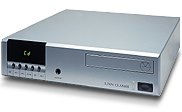| Columns Retired Columns & Blogs |
Linn Classik CD receiver
Over the past two decades, enough advances in the high-end audio industry have trickled down to aspiring audiophiles that we now enjoy a level of high-value, high-resolution performance that would have seemed unattainable even just a few years ago. Still, immersion in a profound musical experience remains an ephemeral goal to potential converts, given the level of expertise that seems necessary to assemble a truly audiophile set of separates.
 Now you and me, at the center of whose beings is the experience of music—we'll scheme and save to achieve our sonic dreams. But there are those for whom money isn't the overriding issue, who maybe can't be bothered to add another layer of complexity to their lives. By now, we've heard all the familiar excuses in triplicate: I wouldn't know where to start...I have no place to put it...Who wants to look at all those ugly boxes?...But I only listen to music in the kitchen...Anyway, I couldn't tell the difference... How can we imbue our experience of musical bliss with enough cachet to be pertinent, even essential, to these lost tribes of listeners?
Now you and me, at the center of whose beings is the experience of music—we'll scheme and save to achieve our sonic dreams. But there are those for whom money isn't the overriding issue, who maybe can't be bothered to add another layer of complexity to their lives. By now, we've heard all the familiar excuses in triplicate: I wouldn't know where to start...I have no place to put it...Who wants to look at all those ugly boxes?...But I only listen to music in the kitchen...Anyway, I couldn't tell the difference... How can we imbue our experience of musical bliss with enough cachet to be pertinent, even essential, to these lost tribes of listeners?
Damn, they could've had a V8...
Perhaps by making high-end audio sexy and simple. Unfortunately, "lifestyle" systems have traditionally been triumphs of form over function, sizzle over steak. Marketing icons such as the Bose Wave Radio, and all those electronic objets d'Bauhaus from B&O, project undeniable auras of high-tech styling, and are priced accordingly. But what devout ambassador of hi-rez reproduction hasn't experienced a pang of regret and lost opportunity when a friend shows off some expensive new can of fizz? "Damn, they could've had a V8!"
Enter the Linn Classik: a sleek, unobtrusive, uncomplicated design that does double duty as a lifestyle system and—for those who don't want the hassle of separate components—a true high-end performer.
The lessons gleaned from several generations of high-quality Linn separates, and advances in software and microprocessor technology, have led inevitably to the Linn Classik. This full-functioned receiver houses a no-compromise standalone CD player, a high-quality AM/FM tuner, and a solid-state integrated amp with a MOSFET output stage that provides plenty of current drive and dynamic headroom to drive a variety of real-world speakers. The Classik allows non-enthusiasts a simple, hassle-free means of participating in an authentic, true-to-life musical experience, and offers audiophiles performance comparable to the best separates, with the convenience and cost-effectiveness of a single-box design that eliminates the need for multiple runs of expensive interconnects.
"The impetus for all of this was to improve sound quality," explains Linn's Brian Morris. "We employ high-density surface-mount boards for amplification. Linn has invested in three surface-mount machines in the last five years, and each one costs over a million dollars. Surface-mount is much better than traditional circuitry with hand-placed components and conventional hand-soldering. It's an automated process that allows us to improve production quality and efficiency.
"It's the practice of using high-density components on a smaller board. The components themselves are much smaller; rolls of different components are fed into a surface-mount machine. It employs a computer program to select them, depending on the circuit-board topology, then feeds and places the components in the right place; once they're on the board, they're checked by a pincer that moves very rapidly with a camera, which you view on a monitor—it rejects all the faulty boards automatically. When the board is accepted, it rolls over a solder bath, and all of the connections are soldered that way. Then it is checked over and integrated into the product, the whole idea being to have as short a signal path as possible."
The upshot of this new technology is an incredibly compact, high-performance CD receiver with a wide range of performance and programming functions—though, for me, the hi-fi aspects of the integrated amp and CD player were paramount. And while the Classik's front-panel display offers a variety of functions, it is much more logical to control the Classik with its remote handset, which also triggers advanced functions with multiple keystrokes. While it took some time to learn the lay of the land, I became reasonably practiced in the strings of commands.
- Log in or register to post comments



































